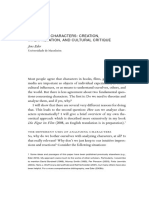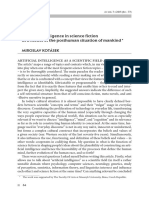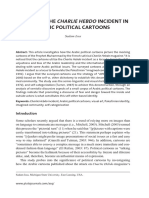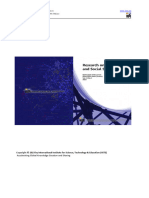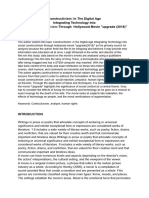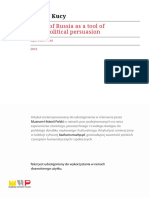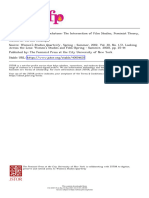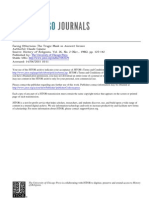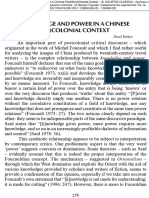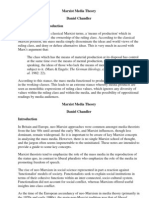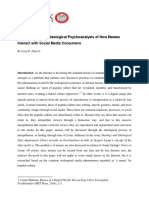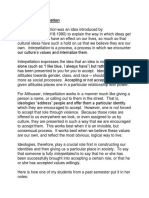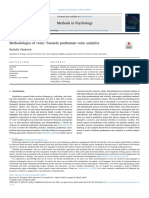Mirrors in Persepolis
Mirrors in Persepolis
Uploaded by
edwardCopyright:
Available Formats
Mirrors in Persepolis
Mirrors in Persepolis
Uploaded by
edwardCopyright
Available Formats
Share this document
Did you find this document useful?
Is this content inappropriate?
Copyright:
Available Formats
Mirrors in Persepolis
Mirrors in Persepolis
Uploaded by
edwardCopyright:
Available Formats
Frames and Mirrors in Marjane Satrapi's Persepolis
Author(s): Babak Elahi
Source: symplokē , 2007, Vol. 15, No. 1/2, Cinema without Borders (2007), pp. 312-325
Published by: University of Nebraska Press
Stable URL: https://www.jstor.org/stable/40550774
JSTOR is a not-for-profit service that helps scholars, researchers, and students discover, use, and build upon a wide
range of content in a trusted digital archive. We use information technology and tools to increase productivity and
facilitate new forms of scholarship. For more information about JSTOR, please contact support@jstor.org.
Your use of the JSTOR archive indicates your acceptance of the Terms & Conditions of Use, available at
https://about.jstor.org/terms
University of Nebraska Press is collaborating with JSTOR to digitize, preserve and extend
access to symplokē
This content downloaded from
54.79.119.62 on Sun, 21 Nov 2021 07:11:26 UTC
All use subject to https://about.jstor.org/terms
FRAMES AND MIRRORS
IN MARJANE SATRAPl'S
PERSEPOLIS
Babak Elahi
Marjane Satrapi explains in an interview in Bitch magazin
Today, it's important more than ever that people know: wha
this "axis of evil"? You are completely reduced to a ve
abstract notion. But the 70 million people [of Iran] are hum
beings, they are not an abstract notion. They are individua
with life, love, hopes. Their life is worth the life of anybo
else in the whole world. (Wood 55)
Indeed, as Edward Said suggests in Culture and Imperialism
of empire - in the literature of the colonizer - involves "th
will to please power in public, to tell it what it wants to hea
that it could go ahead and kill, bomb, and destroy, since w
being attacked was really negligible, brittle, with no re
books, ideas, cultures and no relationship either, it gently
real people" (298). This intellectual will to please power p
Said, using the structuralist terms of Kenneth Burke, calls
of acceptance," a whole way of seeing the world that has "
America" produced "a cultural war against the Arabs and Islam:
appalling racist caricatures of Arabs and Muslims suggest that they are
all either terrorists or sheikhs, and that the region is a large arid slum, fit
only for profit or war" (301). Frameworks of acceptance, then, divide the
abstraction of identity into polarities of good and evil, and it is to this
kind of framing that Satrapi attempts to respond. While Satrapi wrote
her comic-book memoir, Persepolis, before George W. Bush coined the
phrase "axis of evil," she has expressed in a number of interviews1 as
well as in the introduction to Persepolis that she wrote her book in
response to one-dimensional representations of Iran as a terrorist nation.
In response to this ideological framing of Iran, Satrapi reframes its
^e, for example, Tara Bahrampour's New York Times interview.
©symplokë Vol. 15, Nos. 1-2 (2007) ISSN 1069-0697, 312-325.
This content downloaded from
54.79.119.62 on Sun, 21 Nov 2021 07:11:26 UTC
All use subject to https://about.jstor.org/terms
symploke 313
people as " individuals with life, love, hopes." Since Satrapi works in the
graphic novel form, we might consider the ways in which frameworks of
acceptance work in relation to the literal pictorial framing of the comic
art panel. In what follows, I want to connect social science theories of
framing with sequential-art theories of framing, and to subject both of
these to critical theoretical models of ideological interpellation as a frame
structure in order to understand how Satrapi' s book reframes Iran and
reconstructs Iranian subjectivity. Satrapi uses the frame of the comic
panel to redirect the gaze of Western European and North American
readers toward the individual life and the complex identity of her own
narrative and autobiographical persona. At the heart of this process of
reframing is Satrapi's use of mirrors as a motif that doubly frames the
self and allows for a deconstruction and reconstruction of Iranians as
individuals who matter.
Framing
Social scientists Alex Mintz and Steven B. Redd claim that political
leaders set foreign policy agendas through various forms of framing,
including what they call thematic and sequential framing. They give
examples such as Ronald Reagan's framing of the Soviet Union as the
"Evil Empire," George H. W. Bush's framing of Saddam Hussein as
Hitler, and the framing of the war in Afghanistan (by Laura Bush and
Donald Rumsfeld) as the liberation of the women of Afghanistan. We
may wish to add to Mintz and Redd's list something they do not
mention: George W. Bush's framing of Iraq, Iran, and Korea within the
rhetorical structure of "the axis of evil." Mintz and Redd call this
political marketing in which a potentially unacceptable cours
action - invading Iraq, for example - is repeatedly framed through t
same rhetorical structure before, during, and after the course of acti
taken. Though Mintz and Redd don't mention them in their stu
we might recall phrases such as "WMD" and the "axis of evil" a
frames used to guide popular thinking and policy decisions with reg
to Iraq.
Another point I would add to Mintz and Redd's analysis is that this
process of framing takes an issue out of the flow of historical events,
framing them within thematic, structural, or other frames of political
vision. These ideological frames - as they are produced within dis-
courses of political, bureaucratic, or journalistic expertise - tend to draw
attention away from themselves, naturalizing themselves as "common
sense," "liberal humanism," or "objectivity." By contrast, while comic
art does not necessarily draw attention to its own framing mechanism,
neither does it try to conceal it. Unlike film, for example, in which
This content downloaded from
54.79.119.62 on Sun, 21 Nov 2021 07:11:26 UTC
All use subject to https://about.jstor.org/terms
314 Babak Elahi Frames and Mirrors
frames are made to vanish in the flow of projection, comic art uses the
visible frame as part of its aesthetic, cognitive, and narrative form.
Furthermore, it uses these frames to present a segmented flow that can
lend itself to a re-historicizing of what ideological frames would take out
of the flow of history. It is precisely this segmented flow of the pictorial
image in graphic novels - their ability to frame time - that has at least the
potential to restore the historical flow of experience back into the
abstract, ahistoricizing ideological frame. In this sense, comic art can
potentially challenge those modes of political or aesthetic representation
that naturalize their own worldviews by erasing or obscuring their own
frames. Graphic memoir- in the tradition of Will Eisner and Art
Spiegelman, and now in the work of Marjane Satrapi- can negotiate
identity in a way that explicitly questions existing forms of ideological
and psychosocial framing. This is not to say that comic art is non-
ideological. Rather, it is to suggest that the conscious use of pictorial
panels can expose and thus deconstruct the ideological frame.
In Understanding Comics, Scott McCloud points out the importance of
framing in laying out temporal relationships. For McCloud, the
segmented panels of a comic book or graphic novel transform temporal
relationships into spatial ones. In this way, panels within the comic book
create what McCloud calls "a frame of mind" for the reader. Similarly,
Will Eisner, in Comics and Sequential Art, claims that the "artist, to be
successful on this non-verbal level, must take into consideration both the
commonality of human experience and the phenomenon of our
perception of it, which seems to consist of frames or episodes" (38).
Eisner explains:
[the] sequential artist "sees" for the reader because it is inherent
to narrative art that the requirement on the viewer is not so
much analysis as recognition. The task then is to arrange the
sequence of events (or pictures) so as to bridge the gaps in
action .... In visual narration the task of the author/ artist is
to record a continued flow of experience and show it as it may
be seen from the reader's eyes. This is done by arbitrarily
breaking up the flow of uninterrupted experience into
segments of "frozen" scenes and enclosing them by a frame or
panel. (38-39, emphasis added)
Eisner's emphasis here is on the segmenting and framing of the flow of
experience, just as McCloud' s is on the framing of time- time frames.
But both conclude with a broader notion that this segmenting of time
provides a frame of mind, as McCloud puts it, or performs the task of
seeing for the reader as Eisner has it. In this sense, then, pictorial
framing can be related to ideological framing - the filtering of
information, of news, of time, of identities, of nationality and gender -
This content downloaded from
54.79.119.62 on Sun, 21 Nov 2021 07:11:26 UTC
All use subject to https://about.jstor.org/terms
symplokê 315
through templates, through structures of feeling that produce
predetermined judgments of value or narrativized translations of
experience. Both political framing and sequential-art framing aim at
recognition, not analysis. While comic art depends on framing in this
cognitive way, it does not necessarily, but can, point to its own apparatus
of framing. Ideally, the reader of a graphic novel is meant to disappear
into the flow of frames just as surely as the reader of a popular novel is
meant to disappear into the flow of the plot. However, occasionally,
comics draw attention to their own frame-bound nature.
As if to emphasize the importance of framing, for example, Satrapi
often uses frames within frames. Early in Persepolis 2, she represents her
own autobiographical persona in a photo of herself with her Austrian
friend, Lucia. The illustration of the photograph is framed by a picture
frame presented as a gift to Marjane by Lucia's father {Persepolis 2 18).
The frame of the panel encloses the secondary frame of the picture. This
doubly framed image of the self forces the reader to see Marji not only as
an individual but almost as a sister to Lucia - a member of an Austrian
family, flanked by her Austrian sisters, and framed by a present given to
her by their Austrian father. Like the work of Algerian cartoonist Kaci,
Satrapi frames or re-frames the individual life by literally using the
picture frame. One of Kaci's cartoons is a series of framed portraits -
complete with nail and wire showing the pictures hanging on a wall.
The portraits show an Algerian woman, first as a little girl in pigtails,
then as a schoolgirl in a headscarf, next as a uniformed soldier with a
machinegun, and finally as a mother in full hijab holding a baby
(Douglas and Malti-Douglas 186). What Satrapi's framed self also does is
function as mirror. In addition to the frame around the photo, the panel
described above also shows Marji' s hands holding the framed
photograph, making us see the snapshot from her point of view. This
forces any reader - including any "Western" reader - to identify with
Marji, with her gaze upon herself. This kind of mirroring functions both
at the abstract ideological level and at the pictorial level in Persepolis. In
using a motif of more literal mirrors (which I shall discuss in the last
section of this essay), Satrapi forces her readers first to see Marjane (her
autobiographical persona) as a complex individual in search of an
identity, and, secondly, to identify with this complex individual by
seeing her through the frame of the comic book narrative and its panels.
Most importantly, this identification is accomplished not by erasing the
mechanism of framing, but by exposing it through the use of picture
frames and mirrors.
This content downloaded from
54.79.119.62 on Sun, 21 Nov 2021 07:11:26 UTC
All use subject to https://about.jstor.org/terms
316 Babak Elahi Frames and Mirrors
Ref ranting Ideology
Louis Althusser's theory of ideological interpellation includes a
figure that involves both framing and reflection: what he calls a mirror-
structure. In his landmark essay "Ideological State Apparatuses,"
Althusser illustrates the power of the state to recruit subjects through an
example strikingly similar to a scene Satrapi depicts in a three-panel
sequence of her comic book in which the autobiographical hero is hailed
by Islamic morality police. In discussing the way Christian religious
ideology recruits its members, Althusser says that "the structure of all
ideology, interpellating individuals as subjects in the name of a Unique
and Absolute Subject is speculari/, i.e., a mirror-structure, and doubly
speculary: this mirror duplication is constitutive of ideology and ensures
its function" (180, emphasis in the original). In Persepolis 2, Satrapi
depicts the framing of identity in terms that mimic almost exactly
Althusser's model of ideological interpellation.
Althusser writes that he has taken an instantaneous event and
divided it into a sequence (much in the same way that Will Eis
comic-book artist uses panels to frame time):
for the convenience and clarity of my little theoretical theatre I
have had to present things in the form of a sequence, with a
before and an after, and thus in the form of a temporal
succession .... But in reality these things happen without any
succession. The existence of ideology and the hailing or
interpellation of individuals as subjects are one and the same
thing. (174)
Althusser's sequentially framed "theoretical theatre" involves a simple
and vivid verbal illustration. He describes "the most commonplace
everyday police . . . hailing" in which the policeman's "Hey, you there!"
demands the "one-hundred-and-eighty-degree" physical conversion,"
the recruitment of the concrete individual as concrete subject of the state
(174). In this example, the framing device of the mirror, or at least of a
reflection, becomes important: "God is thus the Subject, and Moses and
the innumerable subjects of God's people, the Subject's interlocutors-
interpellators: his mirrors, his reflections" (179).
Satrapi depicts a literal instance of Althusser's theoretical illustration
(Persepolis 2 147). A sequence of three panels depicts Marjene being
literally hailed by the morality police ("Hey -blue coat. Stop running!").
Thought bubbles indicate Marjane's anxiety and confusion. The three
panels culminate in the last image with a mirror-like thought-bubble that
frames Marji's identity as the subject of an Islamic ideological state
apparatus. Inside the frame of the thought-bubble in the last of these
three sequenced panels, Marjane's imagined specular self looks back,
This content downloaded from
54.79.119.62 on Sun, 21 Nov 2021 07:11:26 UTC
All use subject to https://about.jstor.org/terms
symplokê 317
finger pointing to her chest, asking, "Me?" It is almost as if Satrapi were
providing a visual aid for teaching Althusser's concept of ideological
interpellation. This calling out of Marjane in the street by one of the
morality police - the komitehs that enforce moral religious codes -
performs the State-sanctioned recruitment of subjects.
But Satrapi describes a physical event occurring in time, while
Althusser describes cognitive events that "happen without any suc-
cession." He uses the voice of the policeman calling out to the individual
as a metaphor for what happens when the nuclear family, schools, legal
institutions, the church, and other ideological apparatuses offer
individuals normative identities within structures of power. How is the
physical event in Persepolis - actually being hailed by a repressive
policing institution- related to other forms of interpellation? In
Persepolis, other kinds of interpellation function to frame and reflect the
autobiographical subject's identity. The moment when Marji is hailed by
the policeman is, certainly, literal. However, it also works as a synec-
doche, standing in for the wider forms of repressive interpellation at
work in the Islamic Republic of Iran. Indeed, Althusser's notion of
"State" may apply more directly to the Islamic Republic than to secular
European or North American states because of Althusser's use of
"Christian Religious Ideology" as his emblematic illustration of
ideological state apparatuses.
However, Satrapi's Persepolis also explores other kinds of inter-
pellation, those coming out of North American and Western Europe and
reaching into Iran outside of State sanction. Althusser's model has been
criticized by Stuart Hall (1985) and others as too narrowly focused on the
state and as not accounting adequately for civil (private and corporate)
ideological apparatuses. By focusing too narrowly on the state, Althusser
limits our understanding of the much more fluid - as opposed to
structural - ways in which private corporate and institutional power
function in advertising, modes of consumption, and culture in "Western"
industrialized and post-industrial societies. Despite attempting to revise
the traditional Marxist distinction between base and superstructure,
Althusser remains bound by a theoretical model that proceeds from the
political-economic base and sees culture as its superstructural mani-
festation. In looking at how globalized European and American
consumer cultures interpellate Marjane in Satrapi's book, we can
complicate the picture a bit.
For example, in Persepolis, Satrapi describes her adolescent adoption
of punk style and new-wave European and American music. In one
anecdote, she describes her infatuation with Kim Wilde as 1980s music
icon. One image in particular shows how the culture of capital also
interpellates subjectivity through a more fluid reflection. Marjane gazes
This content downloaded from
54.79.119.62 on Sun, 21 Nov 2021 07:11:26 UTC
All use subject to https://about.jstor.org/terms
318 Babak Elahi Frames and Mirrors
at a poster of Kim Wilde and strikes a pose as if looking into a mirror.
The poster is tilted at an angle, and Marji's leaning body mirrors that
angle within the panel (Persepolis 131). The poster, as frame within the
frame, reflects back Marji's fantasy of "Western" cultural or counter-
cultural identity in the image of Kim Wilde whose song "We're the Kids
in America" becomes an anthem for young Iranians who feel stifled by
the Iranian regime's limits on personal style. Satrapi depicts her young
self as performing identity through bricolage, appropriation, borrowing,
and mixture of European and North American styles. While state
structures of interpellation are pedagogical while civil forms of
interpellation are performative, both function as frames and mirrors of
the self, both construct lived fictions of identity.
Placing Marjane's ideologically hailed Islamic identity alongside her
mimicry of Western cultural and commercial (though potentially
counter-cultural) identity, we arrive at the heart of this narrative: the
attempt to piece together a divided identity, a fragmented subjectivity, a
subjectivity that is split not between some absolute and essential "West"
and some monolithic Islam, but between self-consciously iconic and
ideological images of Western and Islamic worldviews. Satrapi presents
one panel as an ironic icon early in her two books {Persepolis 6). The
image divides the panel into two halves. On the left, Marjane's hair is
showing, free of hijab, before a backdrop decorated with gears and
wheels, a hammer, and a ruler. On the right, Marjane is appropriately
dressed in a chador, the backdrop decorated with ornate Persian designs.
This is one of the simplest and most straightforward instances of
framing within Satrapi's work. In it, we see a dichotomy between
tradition on the right, and science and technology on the left. But the
two sides of this dichotomy become more and more difficult to keep
apart, especially once Marjane goes to Europe in Persepolis 2 to find
traditions as rigid as those of Iran. The dichotomy creates a dilemma in
which the autobiographical persona must construct subjective wholeness
out of abstract divisions and fragments of self. She attempts to resolve
this dilemma in large part through her use of the mirror as a doubly
framing motif, bringing her face to face with the competing claims on
identity made not by "Western culture" and a monolithic "Islamic
ideology," but the competing claims presented by familial, educational,
religious, and sexual aspects of Marjane's life.
Mirrors
At the end of the first volume of Persepolis, Satrapi lays out the most
important psychological instance of a mirror frame when she describes
This content downloaded from
54.79.119.62 on Sun, 21 Nov 2021 07:11:26 UTC
All use subject to https://about.jstor.org/terms
symplokê 319
Marji's separation from her grandmother. The grandmother tells her to
be true to herself:
In life you'll meet a lot of jerks. If they hurt you, tell yourself
that it's because they're stupid. That will help keep you from
reacting to their cruelty. Because there is nothing worse than
bitterness and vengeance .... Always keep your dignity and
be true to yourself.
The panel in which this statement appears shows Marji in her
grandmother's bed wrapped in her warm embrace. In connection with
this advice from the family matriarch about the jerks she is bound to
meet through her life, Satrapi presents an almost Proustian motif - the
smell of her grandmother's body: "I smelled my Grandma's bosom. It
smelled good. I'll never forget that smell." We might read this in
Lacanian terms, as a pre-linguistic or extra-linguistic formation of
subjectivity. But the Lacanian model may be too limiting because the
pre-linguistic image he emphasizes is still, nonetheless, visual. What
Satrapi presents in Marji's matriarchal embrace is an imaginary
formation of identity through senses other than the visual. The contrast
between Marji's bodily connection to the ample home of her grand-
mother's embrace and the narrow and fragmenting exile of adulthood is
most striking presented in another image in which the grown-up
Marjane tells her reflection "I will always be true to myself" (Persepolis
151). In this image, Marjane looks into her bathroom mirror, her
reflection half-obscured by the back of her head, her eye registering an
emotion between surprise and anxiety.
Althusser's discussion of the mirror-structure of ideological subject
formation bears the influence of Lacan' s discussion of how a basically
fragmentary subject is made whole through the child's response to her
own specular image within the frame of the mirror. The drama of the
mirror stage moves the individual subject from a sense of insufficiency to
that of anticipation. The sense of not being whole is replaced by a sense
of completeness. To make Lacan's theoretical discussion a bit more
concrete and clear, we might think of how art historian Anne Hollander
describes the function of the mirror in myth and painting. Hollander
writes that the mirror is "a glassy surface and empty frame [that] lie in
wait for the self-portrait that is to be re-created at each reciprocal view of
the artist and his captive subject," and that the "mirror is the personal
link between the human subject and its representation" (391). And,
Hollander explains, while the mirror is sometimes used for certain kinds
of objective evidence about the body - shaving, plucking eyebrows,
etc. - it is most often a device for producing a flattering and self-
deceptive image of the subject. Looking at oneself in the mirror "is at
best an exercise in art, at worst one in self-deception- or at the very
This content downloaded from
54.79.119.62 on Sun, 21 Nov 2021 07:11:26 UTC
All use subject to https://about.jstor.org/terms
320 Babak Elahi Frames and Mirrors
worst, perhaps a path to death and damnation" (393). In this sense,
mirroring is like ideological framing in that it takes the self out of its
social context, and it is like sequential-art framing in that it encourages
(mis) recognition (flattering self-deception) more than it allows for
analysis (objective evidence). The contrast in Persepolis is not only
between a pre-linguistic visual reflection of the self and an adult
linguistic reflection, but a non-visual bodily and sensory reflection of the
self in the matriarchal other, and the visual and exilic reflection of the self
outside the home and the nation.
Taking these discussions of ideology as mirror-structure (Althusser)
or performative reflection (Hall), of subjectivity as being formed through
a mirror-stage (Lacan), and the mirror's pictorial and artistic construction
of a false sense of one's looks (Hollander), it becomes clear in looking at
Satrapi's uses of the mirror as a secondary frame within the comic panel
that Persepolis narrates a problematic development of identity, one which
is agonistic and remains largely unresolved for Marjane as autobiog-
raphical persona. The first instance of the mirror as frame is not a
picture of Marjane herself, but a picture of her mother- with her hair
dyed blonde. She looks back into a bathroom mirror, her mouth in the
curve of a frown, her eyebrows slanted in an expression of worry
(Persepolis 5). Marji's mother has already been framed by Pahlavi-
controlled newspapers, one of which prints a photograph of her
demonstrating in the streets of Tehran (5). Marjane not only reframes
this image of her mother as the picture of a hero, she also connects it
with the more complex image of her mother with blonde hair frowning
at her own reflection. The image of the mother as blonde and her
anxiety about being a revolutionary point to the complex and conflicted
ways in which identities are constructed by ourselves and by others. We
see the mother through the institutional gaze of the newspaper, through
her daughter's refraining of that identity, and through the mother's own
anguished feelings of fear and uncertainty as she is reflected back in a
bathroom mirror, her hair lightened to disguise her chosen identity as
dissenter and her imposed identity as subversive.
This image sets the stage for almost every other framed mirror image
that Satrapi presents of herself as a child and young adult. In most of
them, Marjane's identity - like her mother's in this image - is in doubt in
some way. Here, the mother's fear about political retribution leads her
to disguise her identity. In practically every mirror reflection of herself,
Marjane, like her mother in this image, is frowning or even crying. The
mirror does not function as a reflection of the specular image of the
whole and unified self, something she could only feel when embraced by
her grandmother and not looking in a mirror, but neither does it
completely deceive Marjane. Rather, as Hollander suggests about mir-
roring in general, each view swings back and forth for Marjane between
This content downloaded from
54.79.119.62 on Sun, 21 Nov 2021 07:11:26 UTC
All use subject to https://about.jstor.org/terms
symplokê 321
an exercise in art - mimicry of some kind - and a feeling of possible
damnation, between the performance of self and the subjection and
subjugation of self. Furthermore, in each one, the face reflected back is
partially hidden, as if to suggest the continuing fragmentation or incom-
pleteness of self. And, finally, the last mirror image depicts mother and
daughter embracing, as if to return to this first image and restore
Marjane to a basic psychological sense of identity and home in the arms
of her mother, substituting for that grandmotherly embrace of her
childhood.
In one early mirror image, Satrapi describes her childhood encounter
with two opposed conceptions of the world - one religious and the other
Marxist. After beginning to lose faith in God - who she imagines in the
likeness of Karl Marx - Marjane puts on a cap, stands in front of the
mirror, and pretends first to be Che Guevarra, and then Fidel Castro,
important revolutionary icons for the Iranian left in the 1970s. The image
of Marjene standing in front of a mirror and pretending to be Fidel, like
the image of Marjane's mother, depicts an ambiguity or uncertainty
about self, especially since in the second of this two-panel sequence, she
turns toward the reader and frowns (16). In the second panel, the face in
the mirror is entirely hidden, as Marji's reflected image looks into the
deep emptiness of the mirror's interior, into the annihilation of the
looking-glass world. Marjane looks at the reader but addresses an
absent God, asking "Where are you?" Her reflection remains mute with
its back turned to us. This suggests, perhaps, a frag-mentation of the self
into the speaking subject in search of ontological grounding in a reflected
ideal and the silent or silenced other who turns her back on any such
possibility.
In another image in which the self is framed within a mirror,
Marjane recalls having heard about the tortures inflicted upon Iranian
leftists by the shah's secret police. She recalls coming up with her own
playground tortures that she inflicts upon her playfellows. She looks in
the mirror to see a devilish version of herself looking back: imagined
horns sticking out of her head, a wicked grin on her face. Again, as with
the previous example, this is a two-panel sequence with Marji turned
around to face the reader in the second, narrower, almost claustrophobic
panel, and, again, a half-obscured reflection turns her back on us to look
into the depths of the mirror. Marjane has gone through the looking
glass while Satrapi the author has stepped out of the narrative frame to
express to us her sense of guilt and self -recrimination. Thus, the framing
of the mirror-frame within the panel often functions to represent the
subject's sense of fragmentation.
When Satrapi retells the story of a visit to her uncle in prison, she
presents an image in which her self is fully visible in the mirror.
However, her words suggest an uncertainty about identity. Marjane
This content downloaded from
54.79.119.62 on Sun, 21 Nov 2021 07:11:26 UTC
All use subject to https://about.jstor.org/terms
322 Babak Elahi Frames and Mirrors
asks her mother, "Do you think I'm dressed nicely enough?" (68). This
suggests a tenuous sense of self marked by historical events and political
conflicts that threaten to destroy one of Marji's most important sources
of identity and agency - the mirror she finds in her uncle whose face she
frames with a sun-image - a classic Zoroastrian icon representing Ahura
Mazda, the deity of light, wisdom, and goodness (54). In imagining
herself in relation to this idealized image of her uncle, Marjane registers
a sense of inadequacy. Again, the point here is that mirrors function in
Persepolis as sites of subjective fragmentation, instability, and uncer-
tainty.
In Persepolis 2, Marjane turns to the mirror just before she goes to
pick up her mother at the airport in Austria. Again, like her uncertainty
about her clothed reflection in the previous example, Marjane is uncer-
tain about how she will look to her mother. Also, this example brings us
back to the importance of the mother as a key figure in the authorial
persona's sense of self. The mother's absence and years of change
threaten not only their relationship with each other, but also each ones
relationship with her self. Like her childhood anxiety about looking pre-
sentable enough for a visit to her uncle in prison, here too, she is con-
cerned with how her own mother will perceive her: "I made myself as
beautiful as I could before going to meet her at the airport" (Persepolis 2
46). She thinks this as she looks back at a three-quarter image of herself
reflected in a hall mirror. At the end of her stay in Austria, just as she is
about to leave for Iran, Marjane reflects on the complexity of her own
desire for freedom and individual identity. But her desire to go home
and her need for the familiarity of national and familial belonging drive
her to readopt the hejab and to look in the mirror literally and figure-
atively, in another image that harks back to her mother's worried and
divided gaze into the mirror. Though we do see her full face in the
looking glass this time, it is a face that is, yet again, frowning, lined with
worry (specifically, curved lines under the eyes), and whose thoughts
betray a new uncertainty about her own motivations. Satrapi' s authorial
voice comes in to say: "so much for my individual and social liberties . . .
I needed so badly to go home" (91). Once in Iran, Marjane finds it
difficult to negotiate through the rules governing hejab and gendered
identity. In another scene, she diverts the attention of a moral guidance
committee away from herself- her make-up, her less-than-perfect
hejab- by falsely incriminating a young man sitting nearby, and telling
the authorities that he had been ogling her. The morality police arrest
him, and, though she doesn't know what happens, she suspects they
punish him physically. Upon returning home, Marjane is reprimanded
by her grandmother, the same grandmother who had told her to be true
to herself. "My grandmother yelled at me for the first time in my life."
This is a lapse in her attempt to be true to that self, and again, this
This content downloaded from
54.79.119.62 on Sun, 21 Nov 2021 07:11:26 UTC
All use subject to https://about.jstor.org/terms
symplokè 323
uncertainty is depicted in a mirrored, framed reflection: Marji's face is
flattened because of the angle of vsion. The style of Satrapi's work is
already flat, and, paradoxically, this further flattening is an attempt to
represent perspective (137). The flattening out suggests the superficiality
of what she has done, her shallowness. However, at the same time, the
simulated three-dimensionality suggests a kind of emotional depth: the
loss of her grandmother's approval provides the impetus for her, in fact,
to work towards the ideal self, a self imagined for her by her grand-
mother, her uncle, her mother, and her father (137).
Marriage - as a peculiarly modern Iranian institution - presents
another dilemma for the protagonist's reconstruction of identity, and
again mirrors function to represent the problems of identity formation.
Marjane's attempt to negotiate a public identity as a properly veiled and
modest woman, and a semi-private identity as worldly are brought into
conflict when she is about to be married. Here, she begins to manipulate
her physical look- clothes, make-up, exercise. But she is as uncertain as
ever. She describes being taken by her friends to a salon called
"Wedding Hairdos." One panel gives a frontal view of a hair salon
mirror. Reflected back is Marjane and her hairdresser, whose hair is dyed
blonde, whose wrinkles indicate her middle age, and who is leaning over
displaying ample cleavage. Marji, her hair in an overly adorned frame of
curls, looks back with surprise and shock into the mirror (161). The
whole process of matrimony seems disconnected from naturalized
notions of love, fidelity, and the formation of identities around a nuclear
family. Marjane wants to live with Reza before marrying him (158). But
the only way the two can live with each other is to be married first.
Furthermore, after their marriage, Marjane realizes that her identity is
not permanent, and in a two-panel sequence, she compares the woman
Reza married (Marjane smiling brightly with long hair, wearing make up
and a short dress with lace trim, sitting in front of a window overlooking
a garden with birds) with the woman he found himself living with
(Marjane frowning, smoking a cigarette, dressed in black pants and shirt,
sitting in front of a dark window at night) (164). Thus, the process of
getting married, even for a young woman with enlightened parents,
involves the construction of a self that is hardly recognizable. Again, the
young fiancee's misrecognition of herself is most strikingly registered in
the image of herself looking in the mirror, not knowing what to think.
Finally, the last mirror-image in Persepolis 2 depicts Marjane hugging
her mother. She has just received her mother's reluctant blessing on her
marriage. She does eventually divorce, proving her mother right, but the
embrace in this scene represents the mother's acknowledgement not of
the marriage but of her daughter's adulthood and independent agency.
Paradoxically, this acknowledgement of independence is represented by
an image that underscores subjective inter-dependence. In this image, it
This content downloaded from
54.79.119.62 on Sun, 21 Nov 2021 07:11:26 UTC
All use subject to https://about.jstor.org/terms
324 Babak Elahi Frames and Mirrors
is as if the mother's and the daughter's faces complete each other. In the
foreground, in the initial frame of the comic panel, we see the mother's
face - her hair dyed as in the first image of her we saw reflected in a
mirror. In the mirror - the secondary frame within the frame - we see
Marjane's face in profile. It is in this image that Marjane begins to find a
sense of self. A speech bubble shows Marjane saying, "My sweet little
mom! Trust me, I know what I'm doing" (163). But, as I have said, this
journey is incomplete, and we are left with a sense that Marjane is still in
the process of becoming a complete subject - perhaps like all of us -
rather than already being a complete subject, whether recruited ideo-
logically by the state or existing in some pure and essential sense of self.
Frames vs. Frames
As Satrapi contains the ideological frames of Iranian and Western
misrepresentations of Iran into her own pictorial frames, she is not
replacing these iconic and stereotypical frames of Western media and
Iranian political discourse with "true," accurate, or ideologically neutral
realities. Rather, she is producing a dialectical relationship between her
own iconic images and frames, and the stereotypes and propaganda of
both Iran, and Western Europe and the US. In his study of comics and
ideology, Martin Barker has suggested that it is too simplistic to dismiss
comics or any other iconic framing device (such as television) as
stereotype: a bad and irrational way of seeing that can simply be
corrected through good and rational ways of seeing informed by more
experience and increased knowledge. Instead, Barker offers a dialogic
approach to ideology in which one is aware of the ways in which
different ideologies - different ways of framing one's worldview - really
involve the development and articulation of arguments. This kind of
dialogue and dialectic between one way of framing Iran and another is
precisely what makes Satrapi's work interesting. In her subsequent
books, Satrapi rarely uses panels at all (Embroideries) or constantly breaks
the frame (Chicken with Plums). But in Persepolis, she re-frames concep-
tions of Iran by framing an autobiographical history in the context of her
view of Iran's national history.
It is at the level of the depiction of personal identity - the face in the
mirror - that Satrapi's work is most interesting because she takes her
own experiences of revolution, war, and exile, and presents them to her
readers through a framed iconic image that has a universal look, a look
closer to the iconic end of Scott McCloud's abstraction scale. According
to McCloud, comic art (and, indeed, all pictorial representation) can be
understood as existing along a scale of verisimilitude-abstraction. At
one end of this scale would be the most abstract or iconic: the smiley
This content downloaded from
54.79.119.62 on Sun, 21 Nov 2021 07:11:26 UTC
All use subject to https://about.jstor.org/terms
symplokê 325
face, deer-crossing signs, ideographs, even written words, etc. At the
other end of the scale would be realistic illustrations or photographic
realism. Satrapi's art clearly falls closer to the iconic than the realistic
end of the scale. Her figures are simple line drawings with very little
attempt to produce verisimilitude through detail. She works through a
paradox between a narrative that makes Iranian history and experience
less abstract and a pictorial style that presents her characters as iconic (or
more abstract than photographs or film, for example). In this way, she
frames her own experience as a gift of identification for her reader, like
the picture frame that Lucia's father gives to Marjane as a gift. Satrapi's
Persepolis, while reframing her own autobiography within geopolitical
history, is also iconic enough to be like an empty picture frame into
which the reader can insert his or her subjective experience. She presents
her life as a gradual and incomplete struggle to create a self. And we can
all identify with that.
ROCHESTER INSTITUTE OF TECHNOLOGY
References
Althusser, Louis. "Ideological State Apparatuses/' Lenin and Philosophy and
Other Essays. Trans. Ben Brewster. New York: Monthly Review P, 1971.
Bahrampour, Tara. 'Tempering Rage by Drawing Comics/' New York Times (21
May 2003).
Baker, Martin. Comics: Ideology, Power and the Critics. Manchester: Manchester
UP, 1989.
Douglas, Allen, and Fedwa Malti-Douglas. Arab Comic Strips: Politics of an
Emerging Mass Culture. Bloomington: Indiana UP, 1994.
Eisner, Will. Comics and Sequential Art. Tamarac, FL: Poorhouse P, 1985.
Hall, Stuart. "Signification, Representation, Ideology: Althusser and the Post-
Structuralist Debates." Critical Studies in Mass Communication 2.2 (June 1985):
91-114.
Hollander, Anne. Seeing through Clothes. New York: Viking, 1978.
Lacan, Jacques. "The Mirror Stage." Ecrits: A Selection. Trans. Alan Sheridan.
New York: Norton, 1977.
McCloud, Scott. Understanding Comics: The Invisible Art. New York: Harper
Collins, 1993.
Mintz, Alex, and Steven B. Redd. "Framing Effects in International Relations."
Synthese 135.2 (2003): 193-213.
Said, Edward. Culture and Imperialism. New York: Vintage, 1993.
Satrapi, Marjane. Persepolis: The Story of a Childhood. Trans. Mattais Ripa and
Blake Ferris. New York: Pantheon Books, 2003.
2004.
Wood, Summer. "Scenes from the Axis of Evil: The Tragicomic Art of Marjane
Satrapl." Bitch 22 (Fall): 55-58, 94-95.
This content downloaded from
54.79.119.62 on Sun, 21 Nov 2021 07:11:26 UTC
All use subject to https://about.jstor.org/terms
You might also like
- EDER, Jens. Analyzing CharactersDocument28 pagesEDER, Jens. Analyzing CharactersGiseliNo ratings yet
- Franko Mark The Work of Dance Labor Movement and Identity in The 1930s PDFDocument110 pagesFranko Mark The Work of Dance Labor Movement and Identity in The 1930s PDFJavier Montero100% (2)
- Tzouvala - Capitalism As Civilisation - A History of International Law. 142-Cambridge University Press (2020)Document278 pagesTzouvala - Capitalism As Civilisation - A History of International Law. 142-Cambridge University Press (2020)Catalina100% (1)
- Object Oriented OntologyDocument326 pagesObject Oriented OntologyMark A. FosterNo ratings yet
- Laclau and Mouffe's Discourse Theory and Fairclough's Critical Discourse Analysis: An Introduction and ComparisonDocument26 pagesLaclau and Mouffe's Discourse Theory and Fairclough's Critical Discourse Analysis: An Introduction and Comparisonehsan nooriNo ratings yet
- Political Economy PDFDocument11 pagesPolitical Economy PDFSathyaRajan RajendrenNo ratings yet
- Ideology and The Ideological State ApparatusesDocument22 pagesIdeology and The Ideological State ApparatusesYazid HarounNo ratings yet
- איריס ערבותDocument14 pagesאיריס ערבותAnat DartNo ratings yet
- Facing OthernessDocument19 pagesFacing OthernessDidem OnalNo ratings yet
- How To Read A Graphic NovelDocument20 pagesHow To Read A Graphic Novelmeltem100% (2)
- How It Was': Semiotic Approaches To Soviet ReferencesDocument24 pagesHow It Was': Semiotic Approaches To Soviet ReferencesAmy GareyNo ratings yet
- OptionalDocument17 pagesOptionalDavid EspínNo ratings yet
- Chute TextureRetracingMarjane 2008Document20 pagesChute TextureRetracingMarjane 2008Shria JindalNo ratings yet
- JAMESON, Fredric - Progress vs. Utopia - 1982Document13 pagesJAMESON, Fredric - Progress vs. Utopia - 1982Nicolas CaballeroNo ratings yet
- Whitlock, Gillian. Autographics - The Seeing I of The ComicsDocument16 pagesWhitlock, Gillian. Autographics - The Seeing I of The ComicsVinícius PedreiraNo ratings yet
- Cinema and Society A Search For Meaning in A New GenreDocument21 pagesCinema and Society A Search For Meaning in A New GenreAnonymous c40tCnNo ratings yet
- The Shadow Lines - Ajanta SircarDocument15 pagesThe Shadow Lines - Ajanta SircarEeshitaNo ratings yet
- 15E6 Alice TeodorescuDocument12 pages15E6 Alice TeodorescuSlavko DosenNo ratings yet
- Myths of Individualism in RagtimeDocument16 pagesMyths of Individualism in RagtimeARK234No ratings yet
- WLS4 2015 KotasekDocument14 pagesWLS4 2015 Kotasek////No ratings yet
- Retracing in Sat's PDocument20 pagesRetracing in Sat's PPreitisha GillNo ratings yet
- Lives in Fiction: Auto/biography As Theoretical Narrative: Asia-Pacific Social Science Review January 2014Document19 pagesLives in Fiction: Auto/biography As Theoretical Narrative: Asia-Pacific Social Science Review January 2014PaolaNo ratings yet
- Picturing The Charlie Hebdo Incident in Arabic PolDocument24 pagesPicturing The Charlie Hebdo Incident in Arabic PolmoorpourjouerNo ratings yet
- Monumenta Nipponica Volume 55 Issue 2 2000 (Doi 10.2307 - 2668429) Review by - Allen Hockley - Shunga - Function, Context, MethodologyDocument14 pagesMonumenta Nipponica Volume 55 Issue 2 2000 (Doi 10.2307 - 2668429) Review by - Allen Hockley - Shunga - Function, Context, MethodologyMiguelNo ratings yet
- Jokes, Gender, and Discursive Distance On The Tamil Popular StageDocument30 pagesJokes, Gender, and Discursive Distance On The Tamil Popular StageKanaga VinayagamNo ratings yet
- Toward An Interpretative Destruction ofDocument7 pagesToward An Interpretative Destruction ofsparkhassoNo ratings yet
- Popular Imagination and Identity Politics.1Document24 pagesPopular Imagination and Identity Politics.1Kate A. RoseNo ratings yet
- Decolonizing The Transgender Imaginary - General Editors' IntroductionDocument5 pagesDecolonizing The Transgender Imaginary - General Editors' IntroductiongrecamarinaNo ratings yet
- 2284-10669-1-PBDocument3 pages2284-10669-1-PBjeevaminu59No ratings yet
- You Won T Even Know Who You Are AnymoreDocument15 pagesYou Won T Even Know Who You Are AnymorepugaczowlifeNo ratings yet
- Art History and The Nineteenth Century-Realism and ResistanceDocument25 pagesArt History and The Nineteenth Century-Realism and ResistancennazolgacNo ratings yet
- Progress Vs Utopia Fredric JamesonDocument13 pagesProgress Vs Utopia Fredric JamesonÍcaro Moreno RamosNo ratings yet
- Artikel DramaDocument17 pagesArtikel DramaadelikalilisNo ratings yet
- Seperation Anxiety in Shadow LinesDocument22 pagesSeperation Anxiety in Shadow LinesSagnik Banerjee100% (1)
- Chapter 5Document19 pagesChapter 5gaperah492No ratings yet
- Autographics: The Seeing "I" of The ComicsDocument16 pagesAutographics: The Seeing "I" of The ComicsAnna Katharinne Magalhães e SilvaNo ratings yet
- Myths of Russia As A Tool of Socio-Political PersuasionDocument6 pagesMyths of Russia As A Tool of Socio-Political PersuasionAndreiNo ratings yet
- Committment To FormpdfDocument5 pagesCommittment To FormpdfAnonymous IddV5SAB0No ratings yet
- Art AnalysisDocument3 pagesArt Analysisgelaaxxyy28No ratings yet
- Economic and Political Weekly Economic and Political WeeklyDocument6 pagesEconomic and Political Weekly Economic and Political Weeklycarlos lópez bernalNo ratings yet
- Suvin-Angenot - Reflections of Cognition and Ideology in Science Fiction and SF CriticismDocument13 pagesSuvin-Angenot - Reflections of Cognition and Ideology in Science Fiction and SF CriticismMarti LelisNo ratings yet
- Hanks 1947Document3 pagesHanks 1947Nicolás GonzálezNo ratings yet
- Literature and Politics: Kongi's Harvest As Political Drama: July 2021Document11 pagesLiterature and Politics: Kongi's Harvest As Political Drama: July 2021Festus SandeNo ratings yet
- The Gaze As Theoretical TouchstoneDocument21 pagesThe Gaze As Theoretical TouchstoneandwymoxaNo ratings yet
- Persepolos With ExplanationDocument17 pagesPersepolos With ExplanationmeltemNo ratings yet
- CALAME Facing Otherness - The Tragic Mask in Ancient GreeceDocument19 pagesCALAME Facing Otherness - The Tragic Mask in Ancient Greecemegasthenis1No ratings yet
- Doing Narrative Ethnography (JDG)Document5 pagesDoing Narrative Ethnography (JDG)Daniela Paz Canales OffenNo ratings yet
- Smith 65Document10 pagesSmith 65api-3835858No ratings yet
- טיפוסים סוציולוגייםDocument39 pagesטיפוסים סוציולוגייםAnat DartNo ratings yet
- Heretics Can Still Be BelieversDocument18 pagesHeretics Can Still Be BelieversitaimfNo ratings yet
- Reflexivity ReduxDocument9 pagesReflexivity ReduxBruno BartelNo ratings yet
- Michelle Reid, Urban Space and Canadian IdentityDocument18 pagesMichelle Reid, Urban Space and Canadian IdentityAlquirNo ratings yet
- Modern Dramatic Elements in Three Plays by Henrik IbsenDocument93 pagesModern Dramatic Elements in Three Plays by Henrik IbsenfitranaamaliahNo ratings yet
- Knowledge and Power in A Chinese Post (Semi) Colonial ContextDocument10 pagesKnowledge and Power in A Chinese Post (Semi) Colonial ContextПоручик ЛукашNo ratings yet
- Identifying and interpreting visual metaphors in political cartoonsDocument26 pagesIdentifying and interpreting visual metaphors in political cartoonsLayke ZhangNo ratings yet
- Res Essay IdeasDocument6 pagesRes Essay IdeasMasa Claudiu MugurelNo ratings yet
- Bundgaard Grammaraestheticintuition 2011Document16 pagesBundgaard Grammaraestheticintuition 2011Julia MarczukNo ratings yet
- J ctv65swtz 8Document26 pagesJ ctv65swtz 8Alexis IparraguirreNo ratings yet
- The Figure of Adorno in The Utopian Politics of Fredric Jameson and Slavoj ŽižekDocument26 pagesThe Figure of Adorno in The Utopian Politics of Fredric Jameson and Slavoj ŽižekEdgar LorimarNo ratings yet
- Posthuman Experiences of Men and Masculinities in Ian Mcewan'S Machines Like MeDocument15 pagesPosthuman Experiences of Men and Masculinities in Ian Mcewan'S Machines Like MeYunus GünerigökNo ratings yet
- University of Wisconsin Press Is Collaborating With JSTOR To Digitize, Preserve and Extend Access To Luso-Brazilian ReviewDocument12 pagesUniversity of Wisconsin Press Is Collaborating With JSTOR To Digitize, Preserve and Extend Access To Luso-Brazilian ReviewPedro FortunatoNo ratings yet
- The Imagination and The "I" in Zamjatin's WeDocument13 pagesThe Imagination and The "I" in Zamjatin's WeInbal ReshefNo ratings yet
- Nationalism in sinkingDocument18 pagesNationalism in sinkingKaoru SetaNo ratings yet
- Chmiel, Eliasz. Collective Subjectivity of Literary Characters As Exemplified by Jorge Amado's Marginalized FiguresDocument29 pagesChmiel, Eliasz. Collective Subjectivity of Literary Characters As Exemplified by Jorge Amado's Marginalized FiguresEliasz ChmielNo ratings yet
- Narrative, Genre and Ideology in Video Games: an analysis of gender roles and structures of powerFrom EverandNarrative, Genre and Ideology in Video Games: an analysis of gender roles and structures of powerNo ratings yet
- Sobre OUDART, La SuturaDocument4 pagesSobre OUDART, La SuturailerdaqNo ratings yet
- Azoulay/Honig: Section LeadersDocument10 pagesAzoulay/Honig: Section LeadersLogan CodyNo ratings yet
- Marxist Media TheoryDocument11 pagesMarxist Media TheorymatteocarcassiNo ratings yet
- Memeology: An Ideological Psychoanalysis of How Memes Interact With Social Media ConsumersDocument14 pagesMemeology: An Ideological Psychoanalysis of How Memes Interact With Social Media ConsumersNguyen LongNo ratings yet
- Finding Althusser's GodDocument19 pagesFinding Althusser's GodLorna Quejong IsraelNo ratings yet
- Psychoanalysis and Film Theory Part 1 - A New Kind of Mirror by Paula MurphyDocument23 pagesPsychoanalysis and Film Theory Part 1 - A New Kind of Mirror by Paula MurphynighbNo ratings yet
- Notes On Althusser: Ideology and Interpellation: January 2017Document4 pagesNotes On Althusser: Ideology and Interpellation: January 2017Cristina RaileanuNo ratings yet
- Louis Althusser Ideology and Ideological State ApparatusesDocument15 pagesLouis Althusser Ideology and Ideological State ApparatusesIrvinne Heather Chua Go100% (2)
- InterpellationDocument12 pagesInterpellationAndrew DeSouzaNo ratings yet
- Peter Bell Realism and SubjectivityDocument21 pagesPeter Bell Realism and SubjectivityEthan HuntNo ratings yet
- Musical Participation by BoysDocument396 pagesMusical Participation by BoysPanagiotis SotiropoulosNo ratings yet
- Detailed Lesson Plan (Lit)Document19 pagesDetailed Lesson Plan (Lit)Shan QueentalNo ratings yet
- Notes On InterpellationDocument6 pagesNotes On InterpellationOle BabaleNo ratings yet
- CH 3Document41 pagesCH 3Diana BaRobNo ratings yet
- Rastko Mocnik - Two Types of Idelogical InterpellationDocument21 pagesRastko Mocnik - Two Types of Idelogical InterpellationVladimir TabaševićNo ratings yet
- Cho Topia11 30Document20 pagesCho Topia11 30jorgeNo ratings yet
- 1 s20 S2590260120300084 Main - 230704 - 195722Document11 pages1 s20 S2590260120300084 Main - 230704 - 195722Jon BarrutiaNo ratings yet
- 1AC KilljoyDocument185 pages1AC KilljoylivipannNo ratings yet
- Dolar, Beyond Interpellation (1993)Document23 pagesDolar, Beyond Interpellation (1993)Anonymous CxVXZJphtNNo ratings yet
- Limited Ink: of Repressence, Inkorporation, and Marineation: From Xenophon's OikonomicusDocument24 pagesLimited Ink: of Repressence, Inkorporation, and Marineation: From Xenophon's OikonomicusTony1ukNo ratings yet
- Tyb Unit 8 Literary CriticismDocument6 pagesTyb Unit 8 Literary CriticismAnuNo ratings yet
- Assignment of American DramaDocument17 pagesAssignment of American DramaAnees AbbasNo ratings yet
- Landscape Between Ideology and The AestheticDocument516 pagesLandscape Between Ideology and The AestheticHUGO ARMANDO NATERAS JIMENEZNo ratings yet
- Althusser On Jacques Lacan To IdeologyDocument2 pagesAlthusser On Jacques Lacan To IdeologyCecilia Gutiérrez Di LandroNo ratings yet
